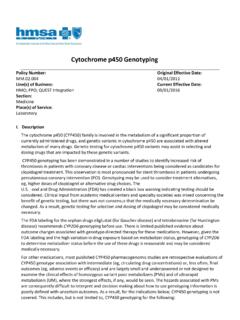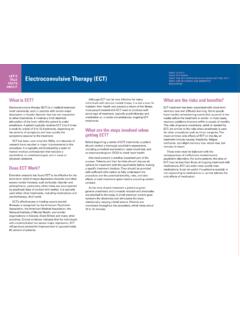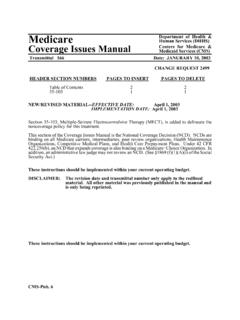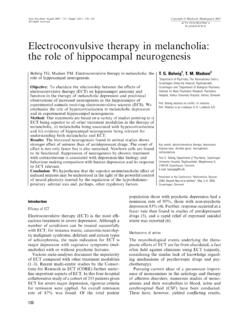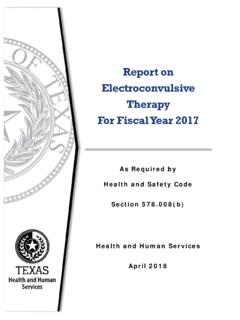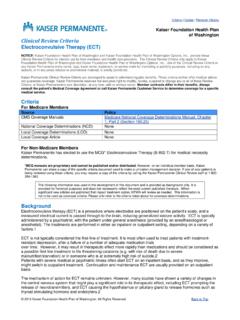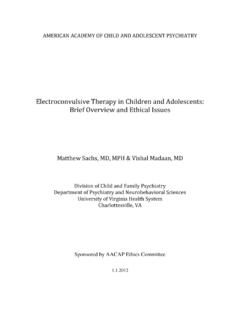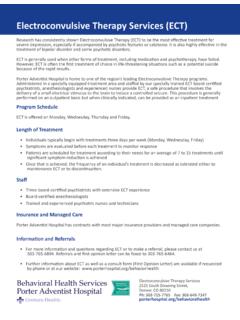Transcription of Electroconvulsive Therapy (ET)
1 Electroconvulsive Therapy (ECT) BEACON HEALTH STRATEGIES, LLC ORIGINAL EFFECTIVE DATE HAWAII LEVEL OF CARE CRITERIA 2013 CURRENT EFFECTIVE DATE 2016 I. Description electro - convulsive (ECT) Therapy is a procedure in which an electric current is passed briefly through the brain, via electrodes applied to the scalp, to induce generalized seizure activity while the member is under anesthesia. This procedure can be administered in a variety of settings, ranging from a licensed hospital to outpatient settings. The principal indication for ECT is major depression with melancholia.
2 The symptoms that predict a good response to ECT are: early morning awakening, impaired concentration, pessimistic mood, motor restlessness, speech latency, constipation, anorexia, weight loss, and somatic or self- deprecatory delusions, all occurring as part of a depressive acute illness. The decision to pursue ECT treatments is based on a risk/benefit analysis based on the member s history, medical issues, symptomatology, and anticipated adverse side effects. Providers must complete a work-up including medical history, physical examination, and any indicated pre-anesthetic lab work to determine whether there are contraindications to ECT-related anesthesia and that there are no less intrusive alternatives before scheduling administration of ECT.
3 The member must provide separate written informed consent to ECT on forms provided by the specific state mental health agency, as consent to other forms of psychiatric treatment are considered separate. The member should be fully informed of the risks and benefits of this procedure and of any alternative somatic or non-somatic treatments. II. Criteria/Guidelines A. Admission Criteria All of the following criteria must be met: 1. DSM or corresponding ICD diagnosis of major depression, schizophrenia, schizoaffective mood disorder , or other disorder with features that include mania, psychosis, and/or catatonia; 2.
4 Member has been medically cleared and there are no contraindications to ECT ( or cardiovascular, or pulmonary contraindications); 3. There is an immediate need for rapid, definitive response due to at least one of the following: a. Severe unstable medical illness; b. Significant risk to self or others; c. catatonia d. Other somatic treatments could potentially harm the member due to slower onset of action. 4. The benefits of ECT outweigh the risks of other treatments as evidenced by at least one of the following: a. Member has not responded to adequate medication trials; b.
5 Member has had a history of positive response to ECT 5. Maintenance ECT, as indicated by all of the following a. Without maintenance ECT member is at risk relapse 2 b. Adjunct Therapy to pharmacotherapy c. Sessions tapered to lowest frequency that maintains baseline B. Continued Stay Criteria All of the following criteria must be met: 1. The member continues to meet admission criteria; 2. An alternative treatment would not be more appropriate to address the members ongoing symptoms; 3. The member is in agreement to continue treatment of ECT; 4.
6 Treatment is still necessary to reduce symptoms and improve functioning; 5. There is evidence of subjective progress in relation to specific symptoms, or treatment plan has been modified to address a lack of progress; 6. The total number of treatments administered is proportional to the severity of symptoms, rate of clinical improvement, and adverse side effects; 7. There is documented coordination with family and community supports as clinically appropriate; 8. Medication assessment has been completed when appropriate and medication trials have been initiated or ruled Limitations/Exclusions III.
7 Limitations/Exclusions A. Discharge Criteria Any one or more of the following criteria: 1. Member no longer meets admission criteria and/or meets criteria for another level of care, either more or less intensive. 2. Member withdraws consent for treatment and does not meet criteria for involuntary mandated treatment. 3. Member does not appear to be participating in the treatment plan. 4. Member is not making progress toward goals, nor is there expectation of any progress. 5. Member s individual treatment plan and goals have been met. 6. Member s natural support (or other support) systems are in agreement with following through with member care, and the member is able to be in a less restrictive environment B.
8 Exclusions Any of the following criteria are sufficient for exclusion from this level of care: 1. The individual can be safely maintained and effectively treated with a less intrusive Therapy ; or 2. Although there are no absolute medical contraindications to ECT, there are specific conditions that may be associated with substantially increased risk and therefore may exclude a specific individual from this level of care. Such conditions include but are not limited to: a. unstable or severe cardiovascular conditions such as recent myocardial infarction, congestive heart failure, and severe valvular cardiac disease; b.
9 Aneurysm or vascular malformation that might be susceptible to rupture with increased blood pressure; c. increased intracranial pressure, as may occur with some brain tumors or other space-occupying lesions; 3 d. recent cerebral infarction; e. pulmonary conditions such as severe chronic obstructive pulmonary disease, asthma, or pneumonia; and f. anesthetic risk rated as American Society of Anesthesiologists level 4 or 5 IV. Administrative Guidelines A. Precertification is not required. HMSA and Beacon reserves the right to perform retrospective review using the above criteria to validate if service rendered met payment determination criteria.
10 B. Applicable codes: Revenue CPT 901 90870 ECT Inpatient or Outpatient Therapy single seizure 901 90871 ECT Inpatient or Outpatient Therapy multiple seizures V. Important Reminder The purpose of this Medical Policy is to provide a guide to coverage. This Medical Policy is not intended to dictate to providers how to practice medicine. Nothing in this Medical Policy is intended to discourage or prohibit providing other medical advice or treatment deemed appropriate by the treating physician. Benefit determinations are subject to applicable member contract language.
